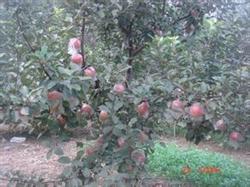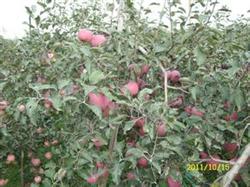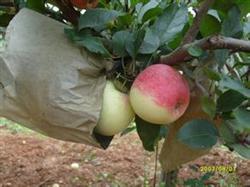Dry cultivation Model of Apple-Alfalfa in Hilly Dryland

1 selection of apple 1.1 varieties. Mid-and late-maturing Red Fuji varieties with high quality, high yield and storage resistance should be selected. 1.2 ground preparation. When the rainy season comes the year before apple planting, dig a planting pit with a specification of 80cm x 100cm. In order to accept natural precipitation and improve the survival rate of seedlings. 1.3 planting time and density. Apple can be planted in spring and autumn, the general row spacing is 2 m × 4 m or 3 m × 5 m, and 44 plants are planted per mu. 1.4 planting. Before planting, 2 kg of expanded chicken manure and 0.5 kg of diammonium phosphate were fully mixed with soil, and the roots of the seedlings were trimmed, soaked in water for 12 hours, then dipped in ABT3 rooting powder 50 mg / kg solution for 3 minutes for 5 minutes, watered after planting in the pit, and buried with soil after water infiltration. 1.5 plastic film covering pit. After the seedlings are planted, the planting pit is covered with plastic film, the hole is broken in the middle, and the soil is compacted around it, showing the shape of a pot bottom, so as to facilitate the infiltration of stagnant water. 1.6 setting dry, sealing soil, bagging. After the seedlings are dried, smear the cut with paint or Vaseline to prevent the cut from losing water. The grass is tied up in autumn before the soil is frozen to prevent frost injury, and the grass is burned when the seedlings sprout. Spring planting with a special film bag tied to the seedlings to prevent the loss of water, seedling sprouting should be checked in time, remove the film bag to prevent burning buds. 1.7 plastic pruning. When the height of the plant reaches 80 cm after planting, it will be reshaped. Generally, the evacuation stratification is adopted, with 3 lateral branches per plant. At the same time, the branches are pulled according to the shape of the plant. In the fruiting period, winter and summer pruning should be carried out in time according to the shape of the tree to remove diseased and withered branches to ensure the healthy growth of the tree. 1.8 the tree plate was covered with grass and plastic film. The tree disk is covered with plastic film every spring or autumn, and the plastic film area is equal to the vertical projection area of the branch and crown. The joint of the plastic film is compacted with soil, and the soil belt is pressed on the plastic film between the plants. Or every year after autumn in the tree plate around the grass, each plant with about 20 kilograms of grass, after the cover with soil compaction, to prevent wind and fire. Straw can be made of wheat straw, corn straw and rice straw. 1.9 change the soil. Combined with fertilization, a circular ditch with a width of 50 cm to 60 cm and a depth of 80 cm was dug under the tree plate every year in the rainy season, and the hole was deeply turned and enlarged for 3 consecutive years to improve the soil structure and increase the soil water storage and moisture conservation capacity. 1.10 popularize water-saving drip irrigation. Construction of water cellars, pits and ponds and other accumulated natural precipitation, supporting drip irrigation facilities, the implementation of drip irrigation. 1.11 use biochemical agents. In order to improve the drought resistance and water retention capacity of soil and fruit trees, popularize the application technology of moisture increasing agent and drought resistant agent. One is to apply 5 grams of strong soil moisture increasing agents such as LPA-1, LPA-2 and LSA-2 to each tree under the fruit tree; the second is to spray the leaves with "FA Handilong" 500x liquid for 2 times for 3 times; and third, according to the apple growth situation and drought, appropriate application of Luheng, Tianbao high efficiency yield increasing agent, multi-element foliar fertilizer and other regulators to enhance apple stress resistance. (2) selection of alfalfa 2.1 varieties. Select varieties with cold tolerance, drought tolerance, high yield regeneration and high crude protein content, such as American L323, Canadian FD4 and so on. 2.2 fertilization and soil preparation. In spring and autumn, 2000 kilograms of farm manure, 13 kilograms of diammonium per mu or 50 kilograms of superphosphate and 5 kilograms of potassium sulfate were applied to the surface of apple trees in spring and autumn. 2.3 seed treatment. Selecting the seeds carefully before sowing and drying the impurities-free seeds in the sun for 3-5 days can promote the seed maturation and improve the germination rate. 2.4 sowing 2.4.1 sowing date. Alfalfa can be sown all the year round, but the best sowing time is spring sowing (March-April) and autumn sowing (August-mid-September). Spring sowing should take advantage of soil moisture, autumn sowing is after the rainy season, the temperature is suitable, which is conducive to germination and root development, sowing too late is not conducive to safe overwintering. 2.4.2 sowing form. The distance between alfalfa and apple is 50-60 cm. The sowing is mainly by strip sowing, and the emergence of seedlings is neat, which is convenient for the management of ploughing, weeding, fertilization and so on. The line spacing is generally 30cm to 40cm. 2.4.3 sowing depth. Alfalfa seeds are small and weigh about 2 grams, so it is not suitable for deep sowing. The sowing depth is generally 1-1.5 cm, with slightly shallower soil moisture and deeper ground dryness. After sowing, alfalfa seeds are suppressed, so that the soil is closely connected with the seeds, and it is easy to absorb water and germinate. 2.4.4 broadcast quantity. As a grass harvesting field, the sowing amount can be larger, the seed harvesting can be smaller, the sowing amount of the land with low fertility can be larger, and the sowing amount per mu should be controlled at 0.75 kilograms. 2.5 Field management 2.5.1 topdressing. During the growth period of alfalfa, topdressing is mainly phosphorus and potassium fertilizer, which can be sprinkled, strip applied or foliar spraying. In spring, 1520 kg of phosphate fertilizer or 10 kg of diammonium fertilizer can be applied in the soil moisture mu, and the extra-root topdressing is 0.1% 0.5% potassium sulfate, and the topdressing time is carried out before turning green every year or after each harvest. 2.5.2 Prevention and control of grass famine. Weeds compete with alfalfa for water, fertilizer and glory, and reduce the yield and quality of alfalfa. Therefore, alfalfa for more than one year can weed weeds before turning green in early spring, and at the same time achieve the purpose of loosening soil temperature and preserving soil moisture. After each harvest, the weeds can be ploughed and harvested at the right time to reduce the residue of weed seeds. 2.5.3 drainage. Alfalfa is resistant to drought and waterlogging, once there is stagnant water, it will cause a large number of root system death. Therefore, stagnant water should be eliminated in time in the rainy season to ensure the sustained and healthy growth of alfalfa. 2.5.4 Control of diseases and insect pests. Alfalfa pest control advocates the principle of biological control or physical control, supplemented by chemical control, in order to control diseases and pests. 2.6 harvest 2.6.1 harvest time. The best harvest period is from the budding stage to before flowering, and the last harvest is no later than the end of September, which affects the safe overwintering and next year's yield. 2.6.2 number of harvests. One crop can be harvested in the spring sowing year, but not in the autumn sowing year, and 3-4 crops can be harvested every year in the second year. The first crop can be harvested in mid-late May, and then it will be harvested every 40 days or so, and the last harvest in late September. 2.6.3 stubble height. The crown of alfalfa rhizome is the growing point of regenerated grass, and the height of stubble affects the yield and quality of the next stubble. The harvest height is not less than 5 cm on the rhizome, and the height of the last harvest is not less than 10 cm, so as to survive the winter safely. 2.7 when apples enter the full fruiting stage, alfalfa can be used as green manure to increase soil fertility and improve soil structure.
- Prev

How to make young apple trees bear fruit early
In the current production, some orchards, soil conditions are better, fertilizer and water are more sufficient, but the planting density is too large, and the management after planting cannot keep up, especially the correct use of pruning techniques to promote early flowering results, resulting in over-dense populations, coverage rates of 90%, or even 110%, crown handover rates greater than 20%, and mu branches.
- Next

The time and method of Apple bagging
Bagging time except for apple varieties which are prone to fruit rust, early and medium-maturing apple varieties are usually bagged about 30 days after falling flowers, and mid-late and late-maturing apple varieties are bagged 35-45 days after falling flowers. Bagging prematurely, although the apple fruit surface is more smooth when harvested, but because the young fruit stalk is delicate, the fruit will meet the windy weather.
Related
- Moge, come on! The staff of the peasant association in the producing area of cantaloupe were frightened when the crowd gathered.
- Causes and Solutions of low Fruit setting rate of Apple
- Symptoms and control measures of passion fruit virus disease
- Fruit growing lesson: how do apple orchards keep high yields?
- Can you build orchards in the mountains? What are the pros and cons?
- How to manage the coloring period of Crisson grape?
- This paper introduces the processing technology of two kinds of fig products.
- How much is a month for retired teachers in rural areas by 2020?
- How can strawberry planting increase sugar content? We should pay attention to management in many aspects.
- What are the cultivation techniques on how to improve the yield of golden fruit?

